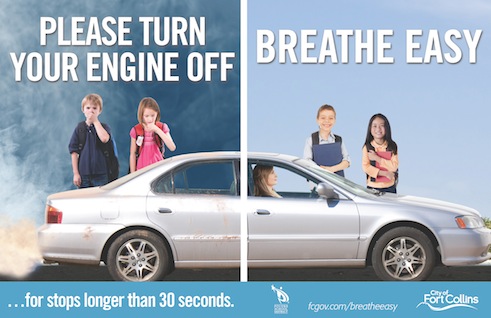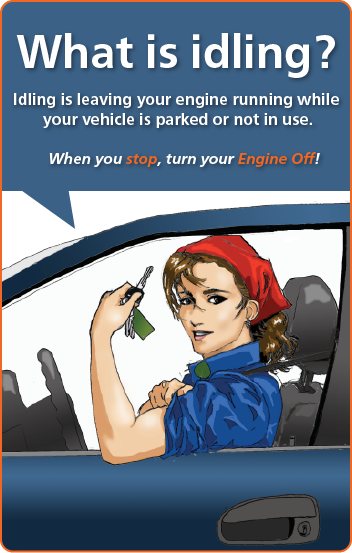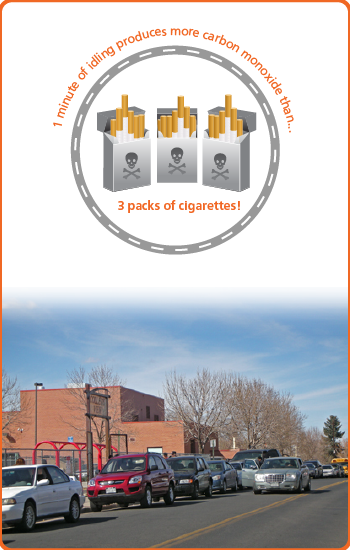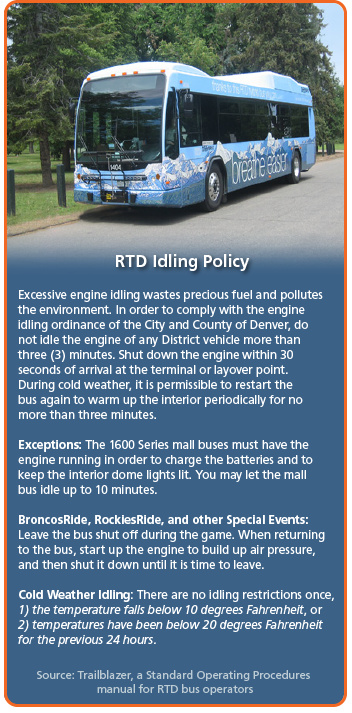Engines Off (former program)
Between 2008 and 2012, the first Engines Off program launched as a collaborative effort between federal, state, local governments, and NGOs in Colorado to improve regional air quality by reducing vehicle idling, a significant source of air pollution. In 2023, the RAQC revamped the Engines Off program. Below is information preserved from the expired program, much of which is still relevant and true.
Engines Off, information from 2008-2012
Click through to read the information preserved from the expired Engines Off website.
About
While some vehicle idling is unavoidable, such as in traffic congestion or at a stoplight, most drivers end up voluntarily idling their vehicles at various times—in drive-thru lines, waiting to pick-up passengers, while stopped to talk on the phone, and at train crossings, for example. For typical drivers, voluntarily idling adds up to an average of 5-10 minutes a day. Consequently, most drivers end up wasting one to two tanks of fuel per year due to idling.
In 2011, the state passed HB11-1275, which became effective on July 1, 2011. The statewide idling law allows communities to limit idling to five minutes within a sixty-minute period for large, commercial diesel vehicles (14,000 lbs or more), with certain exemptions.
Some local jurisdictions have also adopted anti-idling ordinances that limit idling of all motor vehicles operating in their community. For example, the City & County of Denver has an ordinance that prohibits all vehicles (cars, trucks, buses, motorcycles, etc.) from idling for more than five minutes in a one-hour period, with certain exemptions. Additionally, Colorado Revised Statute 42-4-1206, more commonly known as the “puffer” law, allows law enforcement officers across the state to immediately ticket individuals who have left a vehicle running unattended for any period of time.
In 2008, Engines Off! Denver, the City’s idle reduction program, worked on two major activities to reduce vehicle idling in Denver. First, Denver hosted the Democratic National Convention. In anticipation of the dramatic increase in visitors to the city and under then-Mayor John Hickenlooper’s direction to make it the “greenest convention ever,” stakeholders from across the transportation, tourism, and hospitality industries collaborated on plans to minimize the impact of so many visitors to the city. Engines Off! Denver participated in these green transportation efforts, including hosting workshops for professional drivers. Second, Engines Off! Denver partnered with the American Lung Association in Colorado and local school districts to develop a pilot idle reduction campaign at schools, which became Clean Air at Schools: Engines Off (CASEO).
Both of these activities were made possible by Federal Congestion Mitigation and Air Quality (CMAQ) grant funds administered through the Colorado Department of Transportation (CDOT). Engines Off! Denver continued to demonstrate sound program development and implementation practices, so CDOT contracted with them to develop an online tool kit with information and strategies for the general public, communities and local government agencies to start their own idle reduction programs at the local level. This menu application with targeted information and sample materials for the various driving sectors provides cost-effective, statewide distribution of idling information, resources, and proven program models.
Partners
Engines Off! Denver has conducted focus groups when implementing pilot idle reduction campaigns. Participants support the research findings that different messages and information sources are necessary to motivate different drivers to turn their engines off. For example, parents responded to information about the dangers of vehicle emissions delivered by a trusted community champion or public health organization, such as the American Lung Association in Colorado. On the other hand, commercial diesel truck drivers were more likely to be influenced by messages about saving money through reduced fuel and maintenance costs from equipment manufacturers, such as Ford Motor Company or Cummins. Therefore, a successful idle reduction campaign should be a diverse collaboration of governments, nonprofit organizations, transportation organizations, and community members to address the full spectrum of drivers.
Engines Off! Colorado’s partners included:
American Lung Association in Colorado
Denver Department of Environmental Health
Regional Air Quality Council
Colorado Department of Public Health and the Environment
Clean Energy Economy for the Region (CLEER)
Denver Metro Clean Cities Coalition
Denver Regional Council of Governments
Garfield Clean Energy
Rocky Mountain Clean Diesel Collaborative
US Environmental Protection Agency (Region 8)
Local Efforts
Anti-idling laws and ordinances are becoming more common, however, various local efforts have proven that you can spread the word about engine idling and make a difference without having the laws and ordinances to support the message.
FORT COLLINS, COLORADO
The city of Fort Collins, Colorado, has a local anti-idling program called Breath Easy. The efforts of the Breathe Easy Program are aimed at reducing unnecessary vehicle idling in the Fort Collins area by encouraging residents to turn their engines off if their vehicle will be sitting idle for 30 seconds or more.
THE PEPSI CENTER
The Pepsi Center, the home to the Denver Nuggets and Colorado Avalanche and a concert venue, launched a program called Play Clean to support various environmental initiatives. As part of the Play Clean program, the Pepsi Center has designated preferred spaces specifically for hybrid cars. Additionally, signs were posted in front of the Pepsi Center box office promoting the area in front of the box office as a No Idling Zone. The signs were placed with the purpose of reducing the unnecessary idling of vehicles dropping off passengers at the box office and for events at the Pepsi Center.
VAIL, COLORADO
The Town of Vail, Colorado, has an anti-idling ordinance that limits idling to no more than 20 minutes in a one hour period; however, the Town of Vail Employee Green Team thinks they can do better! The Green Team asks all city employees not to idle vehicles for more than 5 minutes in a one hour period as an example to the community. All town vehicles help promote and support idling reduction by wearing bumper stickers that read “idling gets you nowhere.”


Myths & Facts
When it comes to idling your vehicle, there are plenty of misconceptions. Click on a myth below to learn the truth!
MYTH: Pollution emitted from idling vehicles is insignificant to my health and the environment.
FACT: It’s actually quite significant. One minute of idling produces more carbon monoxide than the smoke from three packs of cigarettes. The toxic air pollutants emitted from idling can impair our lungs and heart, and exhaust fumes have been linked to asthma, decreased lung function, cardiac disease, cancer and other serious health problems. Kids, the elderly and folks with respiratory ailments are especially at risk. Idling just one car for five minutes per day can emit as many as 25 pounds of harmful air pollutants and 260 pounds of carbon dioxide a year, the primary greenhouse gas. Throughout the Denver Metro area, idling is responsible for an estimated 40,000 tons of harmful air pollution a year and 400,000 tons of CO2 emissions. This results in over 40 million gallons of fuel wasted while idling, costing area residences and businesses over $100 million dollars a year.
MYTH: Idling is good for my engine.
FACT: An idling engine is not operating at its peak temperature, which means that fuel does not undergo complete combustion. This leaves fuel residue that can deposit on spark plugs and increase fuel consumption by up to 5%. Also, water condensation in the exhaust system can reduce the system’s life.
MYTH: Eliminating unnecessary idling won't save me money.
FACT: One hour of idling can burn up to one gallon of fuel. Most drivers end up wasting 1-2 tanks of fuel per year due to idling. Avoiding five minutes of idling each day can save $35-115 every year, depending on the size of your gas tank. When you idle, you get 0 miles per gallon. Talk about money going up in smoke!
MYTH: It wastes more fuel to restart my vehicle than it does to leave it idling.
FACT: For cars with fuel injection (which includes almost all vehicles built since the late 1980s), idling for even 10 seconds uses more fuel than restarting the engine. In fact, Ford Motor Company recommends that drivers “turn the engine off when stopped for more than 30 seconds to save fuel and reduce exhaust emission.” Of course, we do not advocate turning your engine off while waiting in normal traffic. That’s not a safe opportunity to prevent idling.
MYTH: I should turn my engine off at traffic lights and stop signs.
FACT: While your vehicle is idling during short stops for red lights and stop signs, this is not a safe opportunity to turn your engine off to protect air quality. The Colorado State Patrol and Engines Off Colorado discourage drivers from turning their engines off on active roadways because you cannot predict how quickly you will have to move again. But, you can still safely avoid voluntary idling in common situations, like warming up vehicles in the winter and waiting to pick up passengers.
MYTH: Shutting off and restarting my vehicle is hard on the engine.
FACT: Again, Ford Motor Company recommends turning the engine off, even for stops of 30 seconds, to save fuel, money, and air quality. They have said, “Frequent restarting has little impact on components that include the battery and starter motor.” Component wear caused by restarting the engine is estimated to add $10 per year to the cost of driving, money likely to be saved many times over due to fuel savings from less idling.
MYTH: I need to warm up my car for several minutes in the winter.
FACT: Idling is not an effective way to warm up your vehicle. Modern engines only need to warm up for 30 seconds on cold days. Idling is a slow and ineffective way to warm up your engine. Furthermore, idling your car for several minutes before driving creates extra air pollution, since your car’s catalytic converter is not effective at reducing the pollution in your car’s exhaust until it is sufficiently hot— generally only after driving a few minutes. The best approach is to only idle for 30 seconds, and then just drive gently for the first few miles.
And whatever you do, don’t leave your car running unattended. During the winter months, thieves are on the lookout for cars left idling in driveways, alleys, and at convenience stores—and they’re ready to hop in and drive away in your car! Denver Police can ticket you for leaving a running vehicle unattended.
EXCEPTIONS FOR EXTREME COLD TEMPERATURE: Many idling regulations include exemptions for the cold temperatures that are common in Colorado’s cold winters. For example, the City & County of Denver’s idling ordinance provides exemptions if the ambient temperature has been 20 degrees or colder for the last 24 hours or 10 degrees or colder for the last hour – but this generally occurs only 10-15 days per winter.
Driver Tools
The Engines Off! Colorado campaign provides Colorado communities, businesses, and residents with information about how to protect Colorado’s air quality while saving fuel and money. This online resource addresses the specific challenges, regulations, and needs for various vehicle types in our state. Here you will find targeted messages for these drivers, including facts on the environmental, public health, and financial impacts of idling vehicles, driving tips to avoid idling, plus strategies and tools to start your own engine idling reduction programs at the local level. Click on your vehicle type below to learn more about how you can contribute to cleaner air in Colorado.
Trucks
Do you drive a commercial diesel truck, long haul truck, or local delivery truck? Do you run a business that receives deliveries from these vehicles? The Colorado State idling law, passed in 2011, allows local governments to limit idling by some of these vehicles (commercial diesel trucks, 14,000 lbs or more) to no more than five minutes within one hour.
Many trucking companies have adopted anti-idling policies to control fuel costs. According to Bill Graves, President and CEO of the American Trucking Associations, “Diesel costs remain the number one concern of motor carriers.” Idling a heavy duty diesel truck wastes about one gallon of fuel an hour, which can add up to $5,000-$12,000 in wasted fuel costs plus $2,000 in vehicle maintenance costs per vehicle annually. So, there’s a big incentive for companies to control these costs!
In 2005, Green Mountain Coffee Roasters adopted an anti-idling policy that engaged drivers to reduce unnecessary idling across their nearly 25 truck fleet. As idling dropped from 30% of engine running time to 20% and then 10%, they were able to reduce fuel consumption by 6,816 gallons. At the bulk fuel rate of $3/gallon, this policy saved the company close to $20,500 in fuel costs alone. They likely saved on deferred vehicle maintenance costs as well, such as not having to replace air and fuel filters as frequently.
For long-haul drivers, the most common idling situations are during their rest time when they are heating, cooling, and using appliances in their cabs. Truck stop electrification technology allows truck drivers to provide power to these systems without idling the engine. As of July 2016, there are two electrified rest areas in Colorado, the US Department of Energy’s Alternative Fuels and Advanced Vehicles Data Center has a map that you can search by address to find locations in other states while traveling cross-country. Auxiliary engines are optional as add-ons and they use about 90% less fuel and provide cabin comfort. However, the cost per unit generally exceeds $5,000 and that presents a significant up-front hurdle, especially to independent owner-operators.
Buses
School buses, transit buses, and charter buses all idle while picking up and dropping off passengers and to maintain comfortable cabin temperatures while stopped. However, these vehicles may be subject to local idling restrictions. The Colorado State idling law, passed in 2011, allows local governments to limit idling by some of these vehicles (commercial diesel vehicles of 14,000 lbs or more) to no more than five minutes within one hour.
Companies, such as the Regional Transportation District based in Denver, have adopted internal idling policies to comply with Denver’s idling ordinance and save money on fuel and maintenance. Some school districts have begun charging parents bus fees to compensate for budget gaps to cover rising fuel costs. School bus drivers in communities with idling ordinances are required to observe the law, of course. The Denver Public School District also has installed engine pre-heater technologies on school buses that help them reduce idling to control fuel costs and reduce air pollution, especially inside the cabin where children ride.
Taxis & Limos
Taxi and private car service drivers may idle a lot while waiting for passengers and loading and unloading. Many drivers are typically responsible for fuel costs, so finding ways to avoid wasting fuel will keep more money in your pocket. In addition to turning the engine off while waiting to pick up and unload passengers, decreasing fast acceleration and hard braking events can increase fuel efficiency—and provide a smoother ride for your passengers, too.
Schools
Idling a vehicle for just one minute produces more carbon monoxide than smoke from three packs of cigarettes. Elevated exposure to air pollution can permanently damage children’s respiratory systems because they breathe 50% more air per pound of body weight, spend more time outdoors, and are more active than adults. Yet, adults wait in running vehicles for as long as 30 minutes to pick up their children at school every day.
Clean Air at Schools: Engines Off! (CASEO) is a collaboration campaign between federal, state, and local governments, county school districts, regional air quality planners and non-profit organizations in Colorado. The aim of CASEO is to reduce air pollution exposure at schools in Colorado by working with parents and school administrators to raise awareness of the risks from vehicle emissions and to reduce idling vehicles at pick up time. In addition, CASEO works with school districts to upgrade and retrofit their diesel school buses with emissions control technologies.
In 2012, CASEO received the Model Practice designation from the National Association of County & City Health Officials (NACCHO) as an initiative that demonstrates how local health departments and their community partners can effectively collaborate to address local public health concerns. The program has been added to their Model Practices Database, an online, searchable collection of innovative best practices across public health areas. CASEO, the first idle-reduction campaign to be included in NACCHO’s Model Practices Database, especially stood out to the peer review board for providing measureable results and using community-based social marketing tools to engage its target audience.
Rather than simply provide information to drivers, CASEO uses a community-based social marketing (CBSM) approach to deliver driver education on health risks, public commitment (pledge), and reminders throughout the school year to motivate drivers to turn their engines off. This program model has been demonstrated to be effective in achieving behavior change for public health issues, but it is not commonly utilized for environmental health projects. CASEO has successfully collaborated with schools, students, and parents to improve air quality outside of schools at pick up time. Before and after results from five CASEO schools in the first three years of the program show significant reductions in the percent and duration of idling.
Venues & Events
Venues, such as sports complexes, theaters and performing arts complexes, convention centers, hotels, and other event locations and venues, have traffic from a variety of drivers: semi-trucks, local delivery vehicles, charter buses, public transit buses, school buses, taxis, limos, utility trucks, and guests’ personal vehicles. Carefully planning or revising the traffic patterns around the building can greatly reduce the number of idling vehicles. However, there is a unique challenge to creating such policies because the responsible party is often an event planner who has rented that site for a single event, not the local, onsite venue staff. Therefore, it is important for venue staff to provide suggestions and reminders to clients on how to reduce each event’s environmental impact.
In 2008, the Colorado Convention Center partnered with the City and County of Denver’s Department of Environmental Health to reduce onsite commercial vehicle idling through a social marketing pilot program. They were successful in reducing both the percent and duration of idling vehicles.
Fleets
Some companies and government agencies own and operate a motor pool of multiple vehicle types that many different drivers use to conduct their business and deliver services. Fuel and maintenance costs contribute to a significant portion of their operating budgets. An organization-wide anti-idling policy is one tool that large fleet managers can use to control fuel costs and maintain vehicle exhaust systems because it communicates specific behaviors to a broad audience. Plus, training employees on fuel efficient driving practices can reduce fuel and maintenance costs.
In 2005, Green Mountain Coffee Roasters adopted an anti-idling policy that engaged drivers to reduce unnecessary idling across their nearly 25 truck fleet. As idling dropped from 30% of engine running time to 20% and then 10%, they were able to reduce fuel consumption by 6,816 gallons. At the bulk fuel rate of $3/gallon, this policy saved the company close to $20,500 in fuel costs alone. They also likely saved up to $2,000/truck on deferred vehicle maintenance costs, such as not having to replace air and fuel filters as frequently.
Laws & Ordinances
Many local and state governments have adopted laws and ordinances that limit vehicle idling to combat increasing air pollution and greenhouse gas emissions. Each law and ordinance varies in who it targets, the basic overall structure, and the penalties associated with not complying, however, the overall objective of each law and ordinance remains the same – to protect air quality by reducing emissions created by unnecessary vehicle idling.
Colorado Laws and Ordinances
- Aspen – Limits vehicle idling to five minutes in any one-hour period and the vehicle must be attended to at all times
- Basalt – Limits vehicle idling to no more than two consecutive minutes
- Denver – Limits vehicle idling to five minutes in any one-hour period and the vehicle must be attended to at all times.
- Johnstown – Vehicles weighing more than ten thousand (10,000) pounds are forbidden from idling for more than 15 minutes in any one-hour period
- Greenwood Village – Vehicles weighing more than twelve thousand (12,000) pounds are restricted from idling for a consecutive period longer than five minutes
- Mountain Village – Limits vehicle idling to five minutes within any one-hour period and the vehicle must also be attended to by a licensed operator
- Telluride – Limits vehicle idling to 30 seconds and vehicle must be attended by a driver. Idling time permitted is extended to three minutes for starting an engine in cold weather
- Winter Park – Limits vehicle idling to no more than 15 consecutive minutes
In addition to the laws and ordinances listed above, Colorado Revised Statute 42-4-1206, more commonly known as the “puffer” law, allows law enforcement officers across the state to immediately ticket individuals who have left a vehicle running unattended for any period of time.
Additional Laws and Ordinances from across the United States
- District of Columbia – Limits vehicle idling to three minutes while the vehicle is parked, stopped, or standing, including for the purpose of operating air conditioning equipment in the vehicle
- Salt Lake City, UT – Limits vehicle idling to two minutes within city limits. First offenses are provided a warning, however, subsequent offenses can result in a fine up to $410
- Park City, UT – Limits vehicle idling to three minutes and carries a $100 fine for violators
- Minneapolis, MN – Limits vehicle idling to no more than three minutes in any one-hour period. Vehicle operators may idle for up to 15 minutes in temperatures less than zero degrees or higher than 90 degrees
- Vermont – School buses shall not idle the engine on school grounds for more than five minutes within a one-hour period and must turn off the main engine upon arrival
Common Exemptions Found in Idling Laws and Ordinances
- The ambient outside air temperature has been less than twenty (20) degrees Fahrenheit for each hour of the previous twenty-four (24) hour period; or
- The latest hourly ambient outside air temperature is less than ten (10) degrees Fahrenheit.
- The idling restriction in subsection (a) shall not apply to emergency vehicles; to vehicles engaged in traffic control operations; to vehicles which are being serviced; to vehicles that must idle to operate auxiliary equipment, including but not limited to pumps, compressors or refrigeration units; or to vehicles en route to a destination that are stopped by traffic congestion.
- The time during which transportation vehicles are actively loading or discharging passengers shall not be included in the computation of the five (5) minutes determined herein to be a prolonged or unreasonable period of time. A transportation vehicle shall be defined for purposes of this section to mean motor vehicles designed to transport a minimum of sixteen (16) persons
Citizens
One minute of idling a vehicle produces as much carbon monoxide as smoke from three packs of cigarettes. That’s disgusting!
Idling just 5-10 minutes a day can add up to 1-2 tanks of fuel and $35-115 wasted each year going nowhere.
But the good news is that we can improve our air quality, avoid wasting fuel, and save money by making a commitment to reduce unnecessary idling when safe, like not in traffic.
While your vehicle is idling during short stops for red lights and stop signs, this is not a safe opportunity to turn your engine off to protect air quality. The Colorado State Patrol and Engines OFF! Colorado discourage drivers from turning their engines off on active roadways because you cannot predict how quickly you will have to move again. But, you can safely avoid unnecessary idling in common situations, like warming up vehicles in the winter and waiting to pick up passengers.




